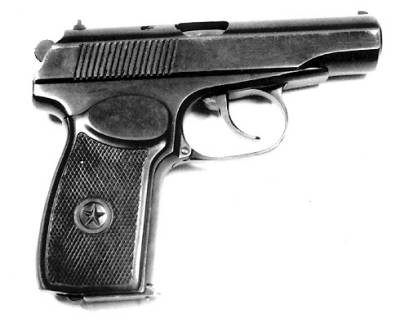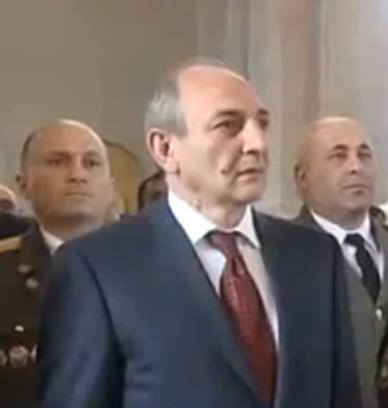|
Vitaly Balasanyan
Vitaly Mikhaili Balasanyan ( hy, Վիտալի Միխայիլի Բալասանյան, born March 5, 1959) is an Artsakhi politician and retired general. He served as the head of the National Security Council of the self-proclaimed Republic of Artsakh from November 2016 to November 2019 and again from December 2020 to January 2023. For his services in the First Nagorno-Karabakh War, he was awarded the country's highest title, Hero of Artsakh. He previously served as a member of Artsakh's National Assembly. He twice ran, unsuccessfully, for the office of President of Artsakh. Early life and career From 1977 to 1979 he served in the Soviet Army and subsequently lived and worked in his native Askeran. In February 1988, Balasanyan participated in the first violent incident of the Karabakh conflict known as the Askeran clash, when a large group of Azerbaijanis attempted to march from Aghdam to Stepanakert, but was stopped at Askeran with fights breaking out. In 1990 Balasanyan was ... [...More Info...] [...Related Items...] OR: [Wikipedia] [Google] [Baidu] |
Askeran
Askeran ( hy, Ասկերան or , ; az, Əsgəran) is a town ''de facto'' in the Republic of Artsakh as the administrative centre of its Askeran Province, ''de jure'' in the Khojaly District of Azerbaijan, in the Political status of Nagorno-Karabakh, disputed region of Nagorno-Karabakh. It is located on the left bank of the Qarqarçay, Karkar River (Qarqarçay), approximately 7 miles northeast of the regional capital, Stepanakert. The town has an ethnic Armenians, Armenian-majority population, and also had an Armenian majority in 1989. History The Askeran Fortress (Mayraberd), built by the Karabakh Khanate ruler Panah Ali Khan in 1751, is situated in the southern part of the town. Armenian historian Shahen Mkrtchyan writes that the Askeran fortress was built upon the foundations of the medieval Armenian village and fortress known as Mayraberd. During the Russo-Persian War (1804–1813), Russo-Persian War of 1804–1813 the Russian encampment was near the fortress. In 1810, p ... [...More Info...] [...Related Items...] OR: [Wikipedia] [Google] [Baidu] |
Battle Of Aghdam
The Battle of Aghdam (June – July 1993) took place on 23 July 1993 during the First Nagorno-Karabakh War, during which Armenian forces captured the Azerbaijani city of Aghdam, which they considered a main staging area of Azerbaijani forces for attacks and artillery strikes against the Armenian-populated Nagorno-Karabakh region. A significant part of the surrounding Aghdam District was captured by Armenian forces as well. According to Human Rights Watch, Armenian forces used the power vacuum in Azerbaijan at the time, and seized Agdam in July 1993. HRW reported that "during their offensive against Agdam, Karabakh Armenian forces committed several violations of the rules of war, including hostage-taking, indiscriminate fire, and the forcible displacement of civilians". After the city was seized, it was intentionally looted and burned under orders of Karabakh Armenian authorities in retaliation for Azerbaijan's destruction of the Armenian-populated city of Martakert. BBC reported ... [...More Info...] [...Related Items...] OR: [Wikipedia] [Google] [Baidu] |
Armenian Apostolic Christians
, native_name_lang = hy , icon = Armenian Apostolic Church logo.svg , icon_width = 100px , icon_alt = , image = Էջմիածնի_Մայր_Տաճար.jpg , imagewidth = 250px , alt = , caption = Etchmiadzin Cathedral, the mother church of the Armenian Apostolic Church , abbreviation = , type = , main_classification = Eastern Christian , orientation = Oriental Orthodox , scripture = Septuagint, New Testament, Armenian versions , theology = Miaphysitism , polity = Episcopal , governance = Mother See of Holy Etchmiadzin , structure = , leader_title = Head , leader_name = Catholicos of All Armenians Karekin II , leader_title1 = , leader_name1 = , leader_title2 = , leader_name2 = , leader_title3 = , leader_name3 = , associations ... [...More Info...] [...Related Items...] OR: [Wikipedia] [Google] [Baidu] |
Hadrut Province
Hadrut Province ( hy, Հադրութի շրջան) was a province of the Republic of Artsakh. The provincial capital was Hadrut city. The last governor was Valery Gevorkian. The province was captured by the armed forces of the Republic of Azerbaijan during the 2020 Nagorno-Karabakh war. It consisted of most of the Jabrayil District, the western part of the Fuzuli District as well as the southwestern part of the Khojavend District. History More than 340 people of Hadrut Region fell victim during the First Nagorno-Karabakh War. During the 2020 Nagorno-Karabakh conflict, heavy fighting took place in and around the city of Hadrut. Independent sources confirmed that the Azerbaijani army took control of the city of Hadrut on either 14 or 15 October 2020. Following the Aras Valley campaign and the Battle of Shusha, all of Hadrut Province was captured by the Azerbaijan Army by 9 November 2020. A peacekeeping contingent of the Russian Federation was placed along the frontline. Ge ... [...More Info...] [...Related Items...] OR: [Wikipedia] [Google] [Baidu] |
Askeran Province
Askeran Province ( hy, Ասկերան) is a province of the breakaway Republic of Artsakh, ''de jure'' part of the Khojaly District of the Republic of Azerbaijan. It is in the center of Artsakh, surrounding the capital, Stepanakert. It is notable for containing the Tigranakert of Artsakh. Settlements There are 42 communities in the province of which 1 is considered urban and 41 are considered rural. Geography Askeran adjoins Martakert Province on the north, Aghdam District of Azerbaijan on the east. Hadrut Province and Shushi Province in the south, Martuni Province in the south east and Kashatagh Province on the west. Stepanakert, the capital of the Republic of Artsakh, is located south-west of the province. History During the Middle Ages the western part of the Askeran Province was part of Principality of Khachen and the eastern part was part of the Principality of Varanda, the center of which was Avetaranots, located in the south of the region. Following the fo ... [...More Info...] [...Related Items...] OR: [Wikipedia] [Google] [Baidu] |
Armenian Apostolic Church
, native_name_lang = hy , icon = Armenian Apostolic Church logo.svg , icon_width = 100px , icon_alt = , image = Էջմիածնի_Մայր_Տաճար.jpg , imagewidth = 250px , alt = , caption = Etchmiadzin Cathedral, the mother church of the Armenian Apostolic Church , abbreviation = , type = , main_classification = Eastern Christian , orientation = Oriental Orthodox , scripture = Septuagint, New Testament, Armenian versions , theology = Miaphysitism , polity = Episcopal , governance = Mother See of Holy Etchmiadzin , structure = , leader_title = Head , leader_name = Catholicos of All Armenians Karekin II , leader_title1 = , leader_name1 = , leader_title2 = , leader_name2 = , leader_title3 = , leader_name3 = , associations ... [...More Info...] [...Related Items...] OR: [Wikipedia] [Google] [Baidu] |
Artsakh Defence Army
The Artsakh Defence Army ( hy, Արցախի Հանրապետության պաշտպանության բանակ, Artsakhi Hanrapetut’yan pashtpanut’yan banak) is the defence force of the breakaway Republic of Artsakh (Nagorno-Karabakh). Established in 1992, it united previously disorganized self-defence units which were formed in the early 1990s with the goal of protecting the ethnic Armenian population of Artsakh from attacks by Soviet and Azerbaijani armed forces. History Establishment The Artsakh Defence Army was founded on 9 May 1992. It created "its own central command and military structure distinct from the Armenian Army." Its founders included Robert Kocharyan (the former President of Armenia, he was the first commander-in-chief of the Army); Serzh Sargsyan (former Prime Minister and President of Armenia); Vazgen Sargsyan (Armenia's Defence Minister 1992–93, State Minister in Charge of defence 1993–95, Armenia's Prime Minister 1998–99); Monte Melkonian (resp ... [...More Info...] [...Related Items...] OR: [Wikipedia] [Google] [Baidu] |
2020 Nagorno-Karabakh War
The Second Nagorno-Karabakh War was an armed conflict in 2020 that took place in the disputed region of Nagorno-Karabakh and Armenian-occupied territories surrounding Nagorno-Karabakh, the surrounding territories. It was a major escalation of an unresolved Nagorno-Karabakh conflict, conflict over the region, involving Azerbaijan, Armenia and the Political status of Nagorno-Karabakh, self-declared Armenian breakaway state of Republic of Artsakh, Artsakh. The war lasted for more than a month and resulted in Azerbaijani victory, with Armenia ceding the Armenian-occupied territories surrounding Nagorno-Karabakh, territories it had occupied in 1994 surrounding Nagorno-Karabakh. The defeat ignited 2020–2021 Armenian protests, anti-government protests in Armenia. Post-war skirmishes continued in the region, including September 2022 Armenia–Azerbaijan clashes, substantial clashes in 2022. Fighting began on the morning of 27 September, with an Azerbaijani offensive along the Nagorn ... [...More Info...] [...Related Items...] OR: [Wikipedia] [Google] [Baidu] |
2020 Artsakhian General Election
General elections were held in the Republic of Artsakh on 31 March 2020, with a second round of the presidential election on 14 April. Voters elected the President and 33 members of the National Assembly. It was the first time the President and National Assembly were elected at the same time. The Free Motherland - UCA Alliance, United Motherland, Justice, ARF, and the Democratic Party won seats in National Assembly. No party won the majority of seats, which means that coalition talks are likely to be held within parties. Presidential candidate Arayik Harutyunyan came first in the first round of the presidential election. A run-off between him and incumbent Foreign Minister Masis Mayilyan was held on 14 April 2020. However, Masis Mayilyan made an announcement urging the people of Artsakh not to participate in the second round of elections in order to prevent the spread of COVID-19. As a result, the majority of Mayilyan's voters from the first round did not vote, and turnout in the ... [...More Info...] [...Related Items...] OR: [Wikipedia] [Google] [Baidu] |
2016 Armenian–Azerbaijani Clashes
The 2016 Nagorno-Karabakh conflict, also known as the Four-Day War,, IPA: ʰɑroɾjɑ pɑtɛɾɑzm az, Dördgünlük müharibə April War,; or April clashes, began along the Nagorno-Karabakh line of contact on 1 April 2016 with the Artsakh Defence Army, backed by the Armenian Armed Forces on one side and the Azerbaijani Armed Forces on the other. The clashes occurred in a region that is disputed between the self-proclaimed Republic of Artsakh and the Republic of Azerbaijan. The region includes the former Soviet Nagorno-Karabakh Autonomous Oblast and surrounding areas, which are integral part of the Republic of Artsakh according to its Constitution. Azerbaijan claimed to prevent purported continuous Armenian shelling of civilian areas in Azerbaijan and started a military operation for this purpose. However, there was no evidence of Armenian shelling. Until the 2020 Nagorno-Karabakh war, the clashes were the worst since the 1994 ceasefire agreement signed by Artsakh, Azerbaij ... [...More Info...] [...Related Items...] OR: [Wikipedia] [Google] [Baidu] |
2012 Nagorno-Karabakh Presidential Election
Presidential elections were held in Nagorno-Karabakh on 19 July 2012. Incumbent President Bako Sahakyan was re-elected for a second five-year term, receiving around two-thirds of the vote. Campaign Four candidates registered to run in the election; incumbent President Bako Sahakyan, Deputy Minister of Defence Vitaly Balasanyan, the rector of Stepanakert University Arkady Soghomonyan and Valery Khachatryan. Khachatryan later pulled out of the election race. As part of the campaign, Balasanyan sent an open letter to Sahakyan, claiming that "authorities have accumulated a vast experience of fraud, illegal involvement of law enforcement and national security agencies in the electoral processes, an inflation of the number of voters on voters’ lists, different kinds of pressure on voters, etc. This has led to apathy in society, distrust of people in the electoral process in the country and a decline of the image of the state." Campaigning ended on 17 July at midnight, with no cam ... [...More Info...] [...Related Items...] OR: [Wikipedia] [Google] [Baidu] |


.jpg)


.png)


